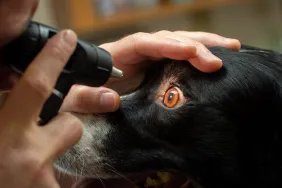Eye injuries are one of the most serious conditions seen by veterinarians. Because pets often mask the clinical signs associated with an injured eye and don’t complain as we do, many pet owners fail to recognize a problem, ignore it, or worse, try to treat it on their own. To help you get a clearer view of your pet’s eyes, let’s look at some of the most common eye problems in pets, how to tell if your pet is affected, and what you should do.
Rule number one: do no harm
Spanky was a small-breed older dog that had been diagnosed with eye problems in the past. It was usually something minor: allergies, infection, nothing serious. So when Spanky began pawing at his eye one evening, his owner searched the medicine cabinet for the last eye medication Spanky had been prescribed.
Two days later, Spanky visited our office in trouble. The vision in his eye was in real danger of being lost. Fortunately, after surgery with a veterinary ophthalmologist, Spanky retained his eyesight. What happened?
Rule number one of any suspected eye injury: never put anything into your pet’s eye without consulting with your veterinarian first. Spanky almost lost his eye because his pet parent administered a medication used to treat inflammation and allergies into an eye with an ulcer. The medication worsened an already severe condition. No matter how many times your dog has experienced an eye problem or the number of pets you’ve owned in your lifetime, don’t let your dog become a Spanky.
Corneal injuries
The cornea is the clear tissue in the front of the eye through which we see. Because it doesn’t have any blood vessels (it’s clear) and it is exposed to the environment most of the time, injuries are common. Many pets will have a scratch on the cornea called a corneal laceration that may become a deeper injury known as a corneal ulcer. These injuries are often caused by a wayward claw, blade of grass, or fight with another animal. They may also be caused by contact with liquids such as shampoos or flea sprays or gases such as smoke.
You can tell if your pet has a corneal injury because it will usually squint, close the eye, avoid bright light, rub at the eye with its paws or you may see a red, bloodshot, swollen or wet eye. The discharge may be clear or yellow-green in color. If you see your pet closing or squinting its eye, have it seen by your veterinarian immediately. Superficial injuries can quickly become infected and a minor injury progress to a major one in a matter of hours. Don’t delay; your pet has only two eyes.
Dry Eye
“Dry eye” is another name for keratoconjunctivitis sicca (KCS). Dry eye is caused by decreased production of tears causing the cornea to become dry and ulcerate. It is described as quite irritating and painful in humans with the condition. The cause is thought to be an inherited immune disorder in certain families of dogs. In simple terms, the dog’s immune cells attack and damage the cells that produce tears. Once the damage is severe, dry eye occurs.
To combat dry eye, an immunosuppressive drug, cyclosporine (also used to fight cancer), is most commonly used. Tacrolimus is also used in some cases. Breeds most commonly affected include: Cocker Spaniel, Boston Terrier, Cavalier King Charles Spaniel, Bulldog, English Springer Spaniel, Lhasa Apso, Miniature Schnauzer, Pekingese, Pug, Shih Tzu, West Highland White Terrier, and Yorkshire Terrier.
Cataracts
Cataracts are one of the most common age-related conditions diagnosed in veterinary medicine. Cataracts are also one of the most common causes of blindness in dogs and cats. You can spot cataracts by the familiar blue to gray hue in your pet’s eyes. As the cataract worsens, you may be able to see a crystalline structure form just behind the pupil.
The great news is that your pet doesn’t have to go blind from cataracts. The same surgery that is performed on people is performed on pets by veterinary ophthalmologists. If you don’t choose to have a cataract removed, your veterinarian should monitor for the development of glaucoma (an increase in the pressure inside the eye).
Many pets with mature or hypermature cataracts (advanced stages associated with blindness or near-blindness) will develop glaucoma. The test for glaucoma is typically performed by a tonometer. This is a pen-shaped instrument that measures the pressure in the eye. The test simply requires your pet’s cornea to be numbed with a topical solution and takes only a few minutes.
Diagnosing Eye Injuries
If your veterinarian suspects an eye injury, the first test performed is almost always a corneal stain. This test consists of applying a dye, typically fluorescein dye, in the eye to detect any tiny breaks in the cornea’s outer layers. Your veterinarian will often examine the eye using magnification and a special blue wavelength of light. If the cornea is damaged, as in Spanky’s case, your veterinarian will avoid eye medications that contain topical steroids. Without knowing if the cornea is damaged or not, your veterinarian cannot safely prescribe eye medications.
If dry eye is suspected in your pet, a tear production test will be conducted. This test involves the use of a special tear-absorbing film that is gently placed in the corner of each eye. The strips are held in the eye for one minute and the amount of moisture wicked on the test strips is measured. If your pet isn’t producing enough tear film, it will be started on cyclosporine or tacrolimus and re-checked in thirty days. Once adequate tear production is achieved, the pet is monitored every three to six months. Treatment is almost always for life in patients with dry eye.
Are dogs colorblind?
One of the most common dog eye myths is “they see in black-and-white.” Not true! According to the latest research, dogs are most likely red-green color blind. This means they see blues and yellows really well but greens and red may be misinterpreted as another hue. Cats are believed to see in color. They seem to prefer color combinations with more contrast. You may interpret this as a dog would enjoy a bright blue bed while a cat favors pink and green polka dots!
Your pet’s eyes are a precious gift; take good care of them. While cases such as Spanky’s are rare, when they occur it’s a sad, avoidable tragedy. When in doubt, ask your veterinarian. Together you can ensure your pet sees the world as it was intended–with you front and center and in full focus!
Ernest E. Ward, Jr., DVM is the owner of E3 Management, a North Carolina-based consulting firm that helps veterinarians improve client service, profitability, and standards of care. He also is owner and chief-of-staff of Seaside Animal Care, a nationally recognized award-winning small animal practice.









